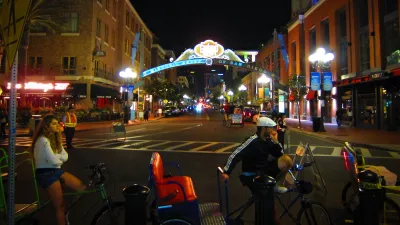San Diego's downtown, dominated by 3-lane one-way streets engineered to maximize car velocity and traffic flow, may be getting redesigned to make it hospitable for bicyclists and pedestrians.

Downtown San Diego's street grid could have made Jane Jacobs proud with its short blocks and multiple cross-streets. Unfortunately, most of that public right of way has been engineered solely for automobile-mobility, with one-way three-lane streets, timed traffic lights, the resultant high speed traffic, parallel parking, and aggressive (and costly) jaywalking enforcement. The auto-oriented street grid leaves little room for cyclists and is inhospitable for walkers, despite the fact that Downtown San Diego's small blocks and concomitant greater number of streets leave ample room to accommodate all modes of mobility.
All that could soon change. The city has issued a draft of the Downtown San Diego Mobility Plan, years in the making, "with a goal of reducing travel by car and increasing trips by bike and foot" writes dedicated downtown urbanist Bill Keller. Among the features contained in the plan,
Perhaps the most ambitious idea is the network of Bike Paths, Lanes, Routes and Cycle Tracks detailed in Chapter 5 Bicycling. For example, a two-way cycle track separated from traffic would run along the west side of Sixth Ave from Beech St down to L St. Cycle tracks are also proposed along sections of Pacific Highway, State St, Park Blvd, Grape St, Hawthorne, Beech, Broadway, C St, and J St.
A public workshop is scheduled for February 23rd and the public review period is open until March 11, 2016. Comments may be submitted at the Mobility Plan website.
FULL STORY: Downtown San Diego Mobility Plan — Draft Released

National Parks Layoffs Will Cause Communities to Lose Billions
Thousands of essential park workers were laid off this week, just before the busy spring break season.

Retro-silient?: America’s First “Eco-burb,” The Woodlands Turns 50
A master-planned community north of Houston offers lessons on green infrastructure and resilient design, but falls short of its founder’s lofty affordability and walkability goals.

Delivering for America Plan Will Downgrade Mail Service in at Least 49.5 Percent of Zip Codes
Republican and Democrat lawmakers criticize the plan for its disproportionate negative impact on rural communities.

Test News Post 1
This is a summary

Test News Headline 46
Test for the image on the front page.

Balancing Bombs and Butterflies: How the National Guard Protects a Rare Species
The National Guard at Fort Indiantown Gap uses GIS technology and land management strategies to balance military training with conservation efforts, ensuring the survival of the rare eastern regal fritillary butterfly.
Urban Design for Planners 1: Software Tools
This six-course series explores essential urban design concepts using open source software and equips planners with the tools they need to participate fully in the urban design process.
Planning for Universal Design
Learn the tools for implementing Universal Design in planning regulations.
EMC Planning Group, Inc.
Planetizen
Planetizen
Mpact (formerly Rail~Volution)
Great Falls Development Authority, Inc.
HUDs Office of Policy Development and Research
NYU Wagner Graduate School of Public Service


























